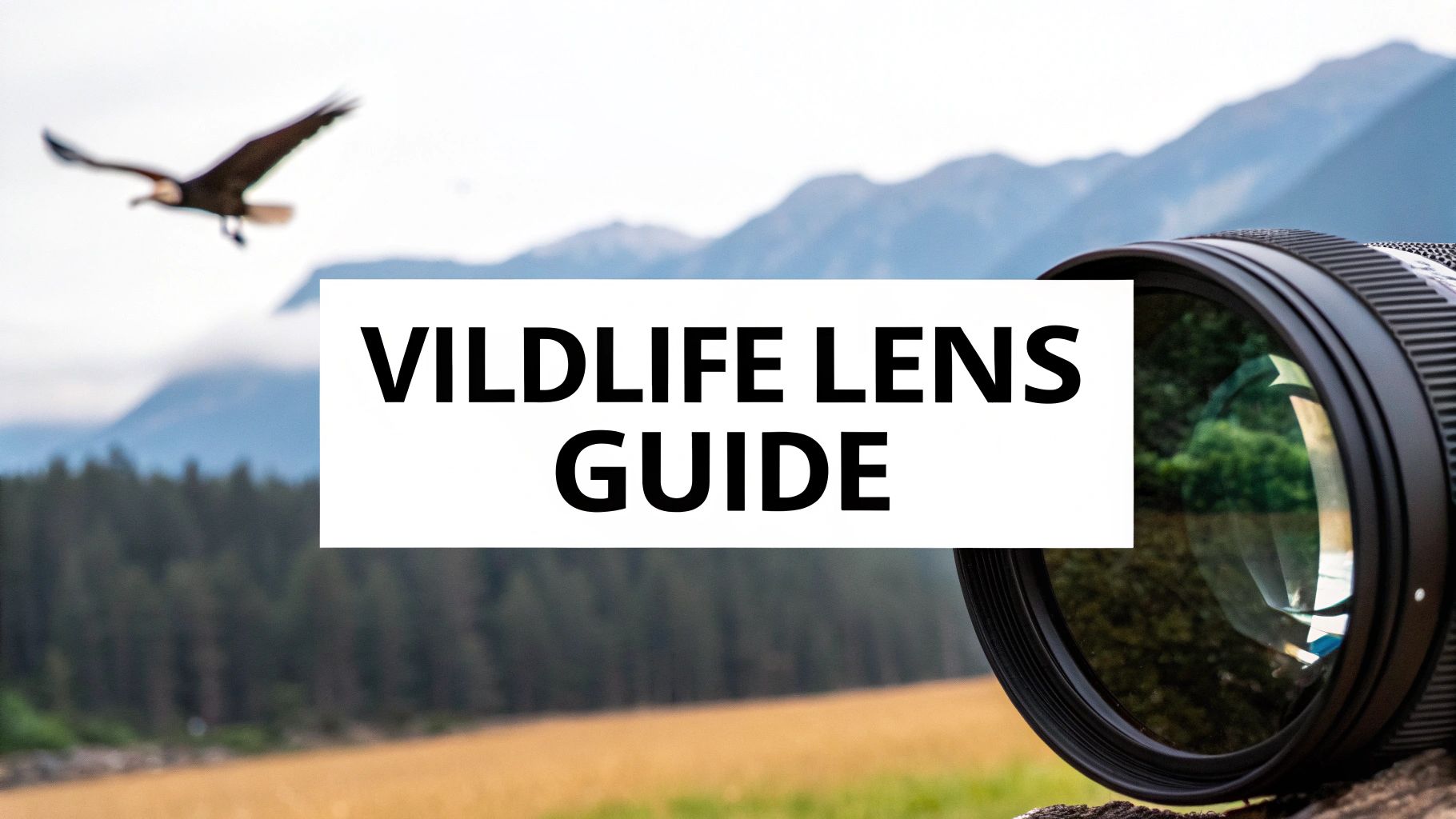
When people ask me what the best lens for wildlife photography is, my go-to answer is almost always a telephoto zoom that reaches at least 400mm. Something like a 100-400mm or a 150-600mm lens gives you the reach you need to capture animals from a safe distance, plus the flexibility to perfectly frame your shot without having to move. While a top-tier prime lens might be technically sharper, a good zoom lens offers the kind of on-the-fly versatility that most of us need out in the field.
How to Choose the Right Lens for Your Wildlife Photos
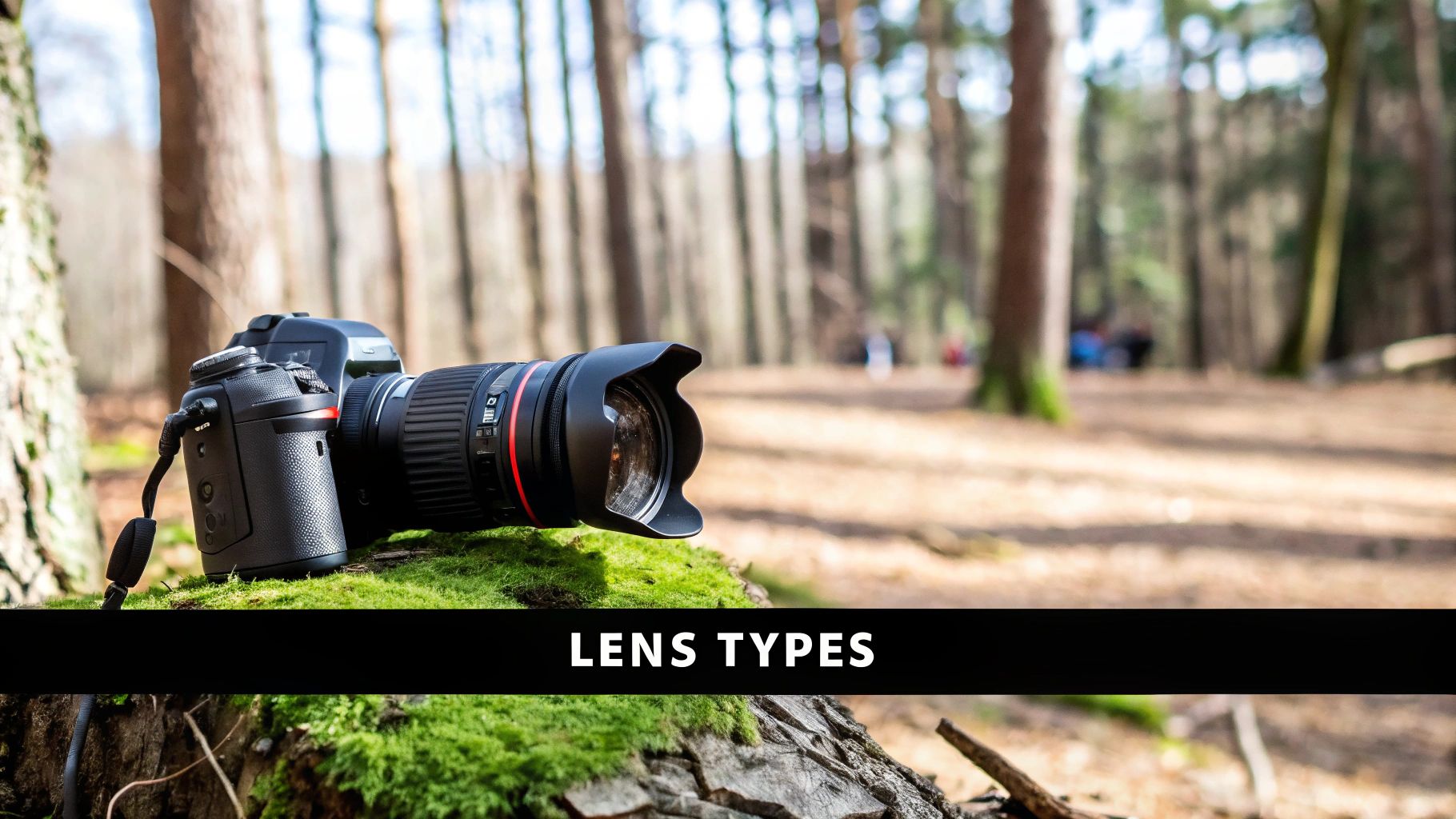
Picking the right lens is your first real step toward getting those jaw-dropping wildlife shots. But here’s the thing: there isn't one "best" lens for everyone. The perfect lens for you depends entirely on what you shoot, where you shoot, and of course, your budget. Instead of just listing options, I want to walk you through how to think about this decision so you can find the glass that truly fits your needs.
Ultimately, your success boils down to four key things: focal length, aperture, autofocus speed, and durability. Get a handle on these, and you'll be able to make a smart choice.
- Focal Length: This is all about reach. A long focal length like 600mm is fantastic for filling the frame with small birds or distant animals. On the other hand, a shorter range around 200mm might be better for larger animals that are a bit closer, or for shots where you want to show the animal within its environment.
- Aperture: This controls how much light hits your sensor and how blurry your background gets. A wide maximum aperture (think f/2.8 or f/4) is a game-changer for shooting in the golden light of dawn and dusk. It also helps you create that beautiful, creamy background that makes your subject pop.
- Autofocus Speed: For wildlife, fast and reliable autofocus is non-negotiable. Whether you're tracking a bird in flight or a running fox, your lens has to be able to lock on and stay on.
- Durability: You're going to be out in the elements. Good weather sealing is what protects your expensive gear from dust, rain, and all the other unpredictable stuff nature throws at you.
The real challenge isn't finding a good lens—there are plenty of those. It’s about finding the right lens for the kind of photography you want to do. The gear a bird photographer needs is worlds apart from what someone tracking elephants on safari requires.
To see what I mean, let’s compare two classic starting points: the do-it-all telephoto zoom and the specialist prime lens. They both have their place, but they come with very different strengths and weaknesses.
| Feature | Telephoto Zoom (e.g., 150-600mm) | Prime Lens (e.g., 500mm f/4) |
|---|---|---|
| Flexibility | Excellent; easily adapt to moving subjects | Poor; you have to "zoom with your feet" |
| Image Quality | Very good to excellent | Exceptional; often the sharpest available |
| Low-Light Ability | Good; smaller max aperture (f/5-6.3) | Superior; wide max aperture (f/4) |
| Cost & Weight | More affordable and lighter | Very expensive and heavy |
Decoding Essential Lens Features for Wildlife
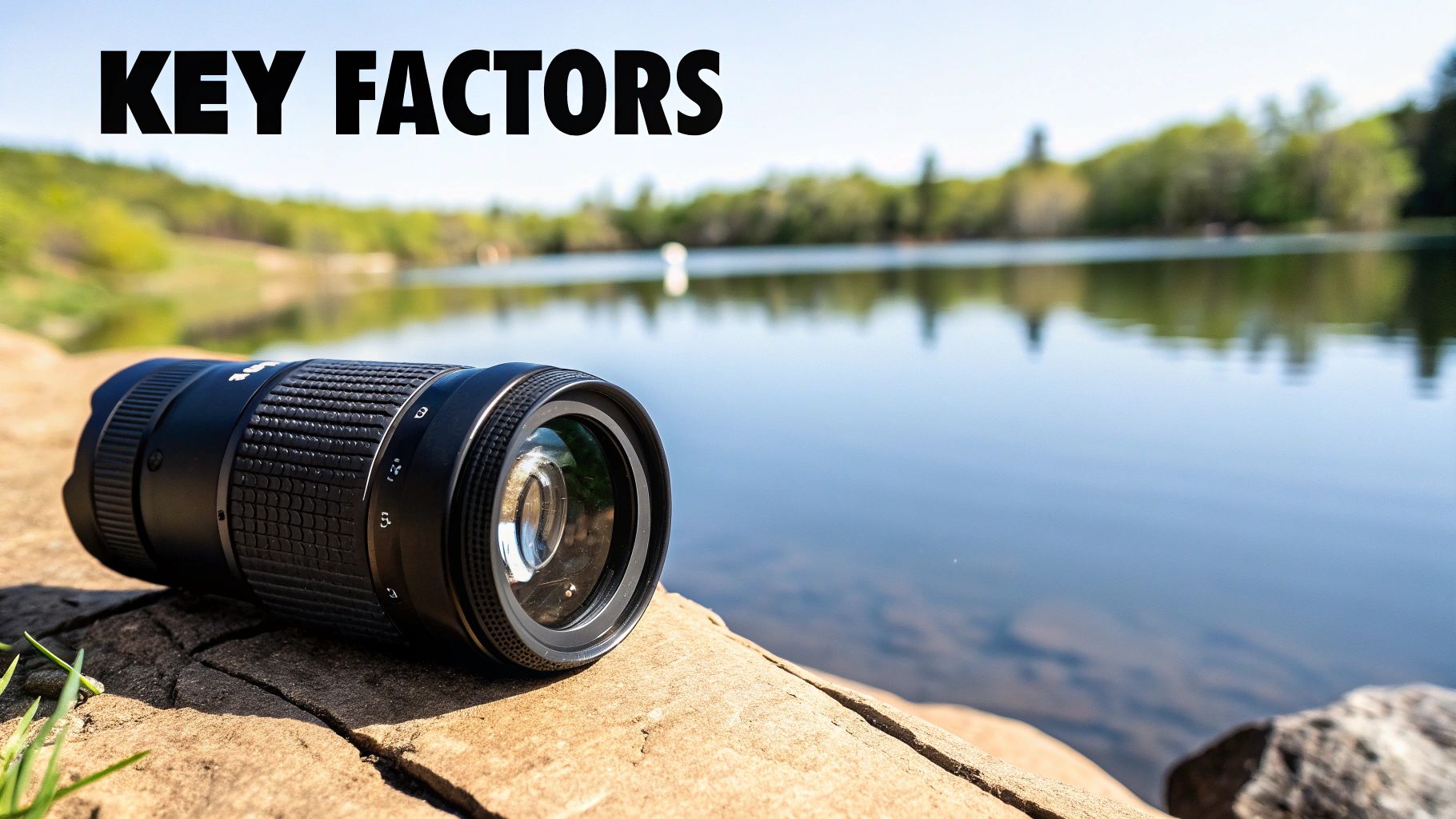
Before we get into specific lens recommendations, let's talk about what actually makes a great wildlife lens. It’s easy to get lost in brand names and marketing hype, but the real magic is in the technology. Understanding a few core features is what separates a smart purchase from an expensive mistake.
These specs aren't just numbers on a sheet; they directly impact your ability to nail that once-in-a-lifetime shot in unpredictable, real-world conditions. Once you get a handle on focal length, aperture, autofocus, and stabilization, you’ll be able to see past the flashy ads and know exactly what you're looking for.
Focal Length: The Power of Reach
In the world of wildlife photography, your biggest enemy is almost always distance. You need to fill the frame with an animal that’s often far away and has no intention of coming any closer. This is where focal length, measured in millimeters (mm), becomes your most critical tool.
A long focal length acts like a telescope, magnifying your subject and bringing it right to you. While a 200mm lens might work for a safari elephant, it will render a distant songbird as little more than a speck. That's why most seasoned pros agree that 400mm is the real starting line for serious wildlife work. Many of us prefer to have 500mm or even 600mm at our disposal to get frame-filling shots of smaller or more skittish animals.
Ultimately, reach allows you to capture intimate, detailed portraits from an ethical distance, ensuring you don't disturb the animal or its habitat.
Aperture: Mastering Light and Depth
Aperture, shown as an f-number (like f/2.8, f/4, or f/5.6), is a powerhouse that controls two things: how much light hits your sensor and your depth of field. A lower f-number means a wider opening, and letting in more light is a massive advantage out in the field.
Think about it—most wildlife is active at dawn and dusk, the beautiful "golden hours" when light is scarce. A wide aperture, say f/4, can be the difference between a tack-sharp image and a blurry mess. It lets you use a faster shutter speed to freeze a bird in flight or a fox on the prowl.
On top of that, a wide aperture gives you that creamy, out-of-focus background known as bokeh. This shallow depth of field is what makes your subject pop, isolating them from distracting foliage and creating a truly professional look.
The ability to shoot at a wide aperture like f/4 or f/2.8 is a game-changer. It not only conquers low-light situations but also gives your images a professional, three-dimensional quality that makes your subject stand out.
Autofocus: Speed and Silence Are Key
Wild animals rarely sit still. A kingfisher diving for a fish, a deer bolting across a meadow—these moments are over in a flash. Your lens’s autofocus (AF) system needs to be lightning-fast, precise, and utterly decisive to lock onto and track that action.
Modern lenses use incredible motor technology, like Ultrasonic Motors (USM) or Silent Wave Motors (SWM). They're built for speed, but just as important, they're nearly silent. Nothing ruins a shot faster than a loud, grinding focus motor that spooks your subject.
When you're comparing lenses, pay close attention to reviews about their AF tracking. The ability to stay glued to an erratically moving animal is non-negotiable for action photography. A lens that constantly hunts for focus will only lead to frustration and a memory card full of missed opportunities.
Image Stabilization: The Handheld Advantage
Even with a quick shutter speed, just holding a big, heavy telephoto lens introduces tiny movements that can soften your images. Image Stabilization (IS)—also called Vibration Reduction (VR) or Optical Stabilization (OS)—is the technology that saves the day.
Inside the lens, gyroscopic sensors detect your hand movements and shift internal elements to counteract them. This is an absolute must-have for anyone who doesn't want to be chained to a tripod.
A good stabilization system can give you 4-5 stops of compensation. In practical terms, that means you can get a sharp handheld shot in much lower light than would otherwise be possible, giving you the freedom to react instantly when you spot a subject. It’s all about staying mobile and flexible in the field.
Telephoto Zoom Lenses: The Versatile Choice
For most of us out in the field, the telephoto zoom lens is the undisputed king. The ability to go from a wide-ish environmental shot to a tight portrait in a split second gives you a creative freedom that prime lenses just can't touch. This is a game-changer when you have no idea how close that grizzly bear or elusive bobcat will get.
Think about it: you're tracking a herd of elk. One second, you're at 600mm getting a detailed shot of a bull. The next, you need to pull back to 200mm to capture two rivals sparring. A zoom lets you do that instantly, reacting to the fluid, unpredictable moments that make wildlife photography so thrilling. This is exactly why they're often the first and best lens recommendation for newcomers and a staple in the bags of seasoned pros.
The good news for all of us is that these lenses are wildly popular, which has created a fiercely competitive market. That means we have fantastic options at every price point, from affordable workhorses to optically stunning premium glass.
The Budget-Friendly Workhorse: The 150-600mm
Lenses in the 150-600mm f/5-6.3 range from manufacturers like Sigma and Tamron have been a gateway for countless photographers. They put incredible reach into your hands for a fraction of what a big prime or first-party zoom costs. This range is your ticket to everything from African safaris to backyard birding.
Of course, that price point comes with a few trade-offs. The variable f/5-6.3 aperture is what we call "slow"—it doesn't let in as much light. This can be a real challenge during those golden hours at dawn and dusk when animals are most active, often forcing you to crank up the ISO and risk noisy images.
While the autofocus is usually quite capable in good light, it can sometimes hunt or miss focus when things get dim. Still, the value here is impossible to ignore. If you're working with a tight budget, a 150-600mm is a phenomenal tool that gets you right into the action.
The Balanced All-Rounder: The 100-400mm
The 100-400mm f/4.5-5.6 lens is where reach, image quality, and portability strike a beautiful balance. These lenses are noticeably lighter and more compact than their 150-600mm cousins, making them a fantastic choice for photographers who hike long distances to find their subjects. If that sounds like you, check out our guide on the ultimate lightweight backpacking gear list for 2025.
While 400mm might not sound as impressive as 600mm, it's more than enough reach for a huge variety of wildlife. What you give up in extreme magnification, you often get back in performance. These lenses tend to have snappier, more reliable autofocus and deliver better sharpness from edge to edge across the zoom range.
For many photographers, the 100-400mm is the sweet spot. It's light enough to carry all day, sharp enough for professional-quality prints, and flexible enough to handle most wildlife encounters, from environmental portraits to tighter shots.
That slightly faster maximum aperture also gives you a small but welcome advantage when the light starts to fade. It all adds up to a do-it-all lens that rarely feels out of its depth.
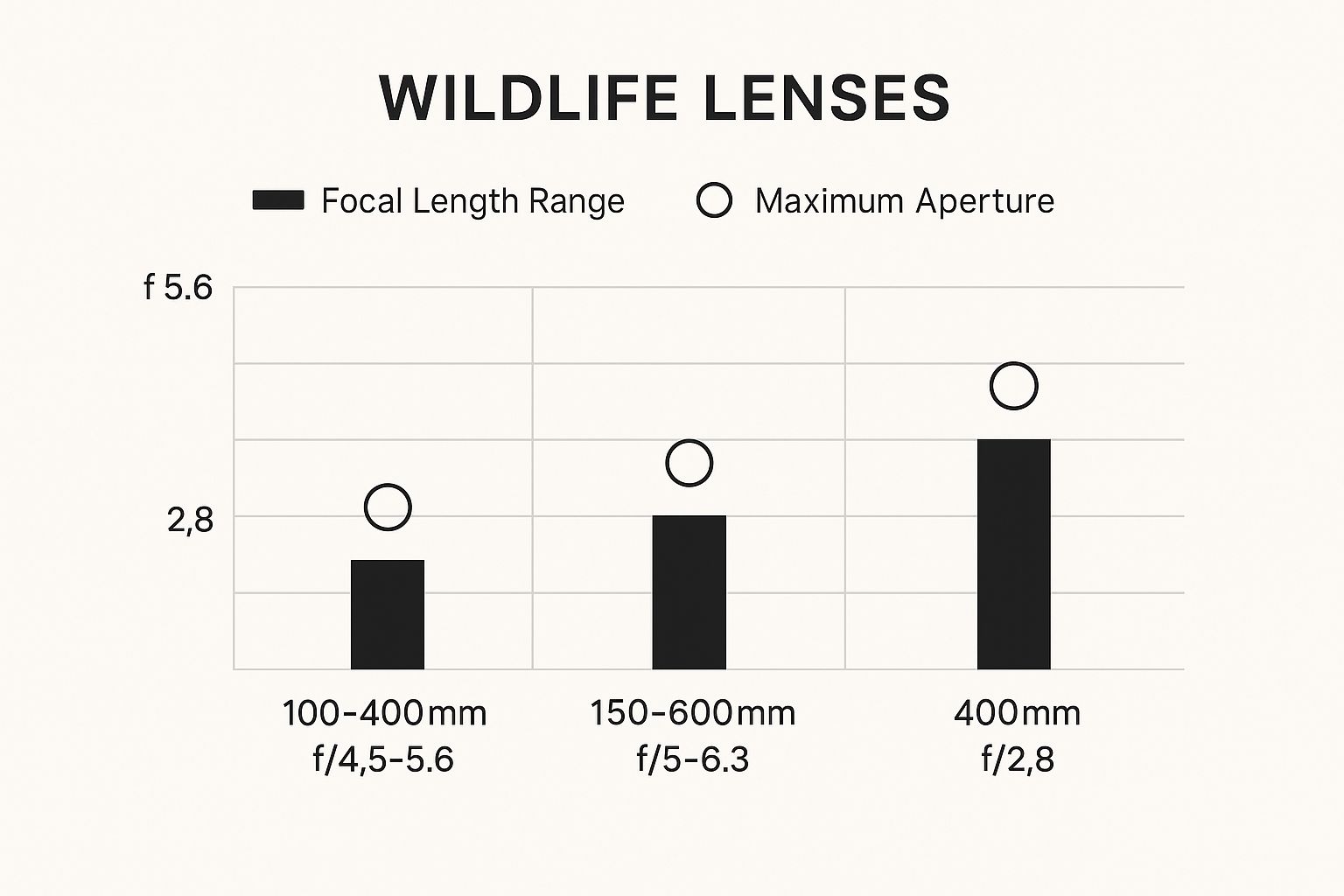
This graphic really puts it in perspective. The zoom lenses offer incredible flexibility across a wide range of focal lengths, while the prime lens (at a fixed length) gives you that huge aperture for conquering low light.
Telephoto Zoom Lens Feature Comparison
Here's a quick look at how these different zoom lens categories stack up in the real world. This table breaks down the key factors you'll want to consider when making a choice.
| Lens Model | Focal Range & Aperture | Autofocus Performance | Image Stabilization | Best For |
|---|---|---|---|---|
| Sigma/Tamron 150-600mm | 150-600mm f/5-6.3 | Good in bright light, can struggle in dim conditions | Effective, crucial for hand-holding at 600mm | Budget-conscious photographers needing maximum reach for distant subjects. |
| Canon/Nikon/Sony 100-400mm | 100-400mm f/4.5-5.6 | Fast and reliable, superior tracking capabilities | Highly effective, pairs well with a lighter lens | Hiking, travel, and all-day shoots where portability and performance matter. |
| Sony 200-600mm | 200-600mm f/5.6-6.3 | Flagship-level; exceptionally fast, accurate, and tenacious | Advanced stabilization for sharp shots | Serious enthusiasts and pros who demand peak AF and optical quality. |
Ultimately, each lens class serves a different photographer. The 150-600mm gets you in the game, the 100-400mm is the versatile workhorse, and the 200-600mm is for those who need uncompromising performance.
The Premium Performer: The 200-600mm
At the top of the zoom lens mountain, you'll find gems like the Sony 200-600mm f/5.6-6.3. The specs on paper might look similar to the budget options, but the real-world performance is on another level. These lenses are packed with flagship autofocus systems that lock on with lightning speed and stick to erratic subjects like glue.
They're also built like tanks, with extensive weather sealing that lets you keep shooting when the weather turns nasty. Optically, they are tack-sharp from one corner of the frame to the other, even when shooting wide open at the longest focal length—a place where cheaper zooms often get a bit soft.
One of the best design features on some of these premium models is an internal zoom. This means the lens barrel doesn't extend as you zoom, which is a huge win for balance, handling, and keeping dust and moisture out. This level of engineering is why telephotos are a cornerstone of the market; the global photography lens market was valued at USD 12.49 billion in 2023 and continues to grow. This is the lens for the serious hobbyist or working pro who needs the very best performance without giving up the versatility of a zoom.
Prime Lenses for Unmatched Image Quality
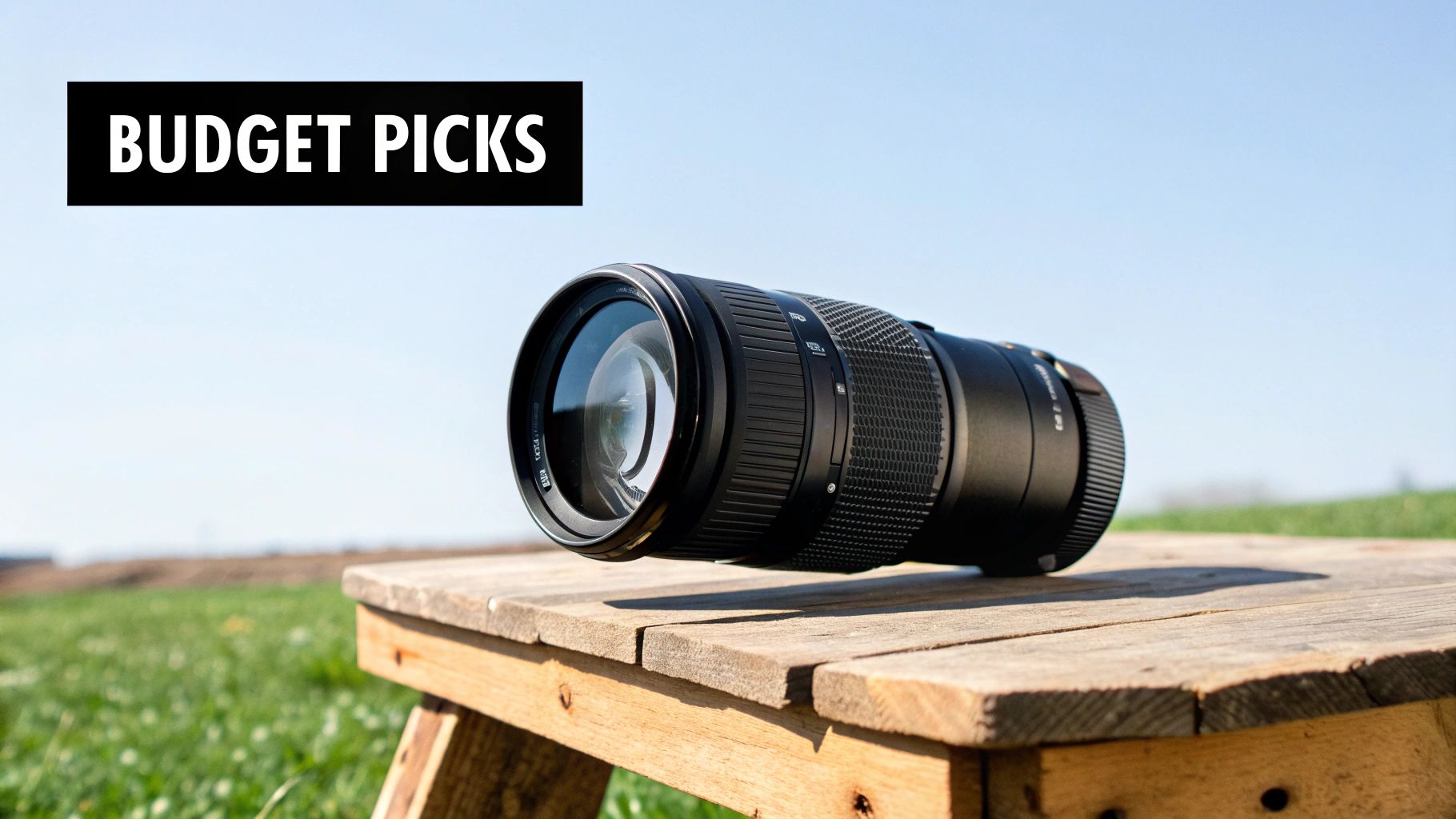
While a good telephoto zoom gives you incredible versatility, there’s another class of lens built for a single, uncompromising purpose: achieving the absolute peak of optical performance. Prime telephoto lenses are the undisputed champions of sharpness, autofocus speed, and low-light prowess. If your goal is to create images that are technically flawless, a prime lens is often the only tool for the job.
These lenses have one fixed focal length, which means no zooming. It might sound like a limitation, but this design simplicity allows engineers to optimize every piece of glass inside for that one specific task. The result is imagery that’s razor-sharp from edge to edge, with gorgeous color and contrast that makes your subjects look almost three-dimensional.
For a wildlife photographer, that level of quality shows up in the details you can resolve—the delicate texture of a bird's feathers, the individual whiskers on a fox’s muzzle, or the tiny catchlight in a distant animal’s eye. A prime lens pulls out these details with a clarity that even the best zooms often struggle to match.
The Power of a Wide, Fixed Aperture
One of the biggest reasons to choose a prime telephoto is its incredibly wide maximum aperture. Legendary lenses like the 300mm f/2.8, 500mm f/4, and 600mm f/4 can gather a massive amount of light compared to most zooms. For anyone serious about finding the best camera lens for wildlife photography, this is a game-changer.
All that light-gathering power lets you use faster shutter speeds when animals are most active at dawn and dusk, which is absolutely critical for freezing motion. It also means you can keep your camera's ISO lower, giving you cleaner, less noisy images with richer colors and better dynamic range.
Beyond that, shooting wide open at f/2.8 or f/4 creates an exceptionally shallow depth of field. This ability is how you get that buttery-smooth, dreamlike background blur (bokeh) that makes your subject pop. The visual separation is dramatic and is a true hallmark of professional wildlife portraits.
When every single pixel matters, a prime lens delivers. The blend of superior sharpness and a wide aperture creates a signature "look" that's tough to replicate, making your subject leap off the screen with stunning clarity and presence.
The Trade-Offs: Flexibility, Weight, and Cost
Of course, this level of performance doesn't come without some major trade-offs. The most obvious is the total lack of compositional flexibility. With a fixed focal length, you have to "zoom with your feet" to reframe your shot. If an animal suddenly moves much closer, you might find your 600mm lens is simply too long, and you’ll miss the shot completely.
This limitation means prime lenses are at their best in specific, predictable situations. They truly shine when you’re shooting from a fixed spot, like a bird blind or a tripod set up near a known fox den. If you know roughly how far away your subject will be, a prime will reward you with unparalleled quality. But for dynamic situations with unpredictable subjects, a zoom is almost always the more practical choice.
Then you have to consider the size, weight, and cost. These are serious, professional-grade tools, and their price tags show it. They are also incredibly heavy, often demanding a sturdy tripod and a gimbal head for any extended use. This makes them a poor choice for photographers who need to hike long distances or stay highly mobile.
Comparing Prime Lens Scenarios
To put this all into context, let's look at when a prime lens is the clear winner versus when a zoom's adaptability is more valuable.
Ideal Prime Lens Situations:
- Stationary Bird Photography: When you're in a hide photographing perched birds or a nest, your distance is fixed. This allows you to pick the perfect prime lens for that one perfect shot.
- Predictable Animal Behavior: Think of capturing bears during a salmon run from a viewing platform or prairie dogs at a well-known colony. These are scenarios where the subject's location is consistent.
- Low-Light Portraiture: If your main goal is creating breathtaking, high-quality portraits during the golden hours, the wide aperture of a prime is simply unbeatable.
When a Zoom Lens Is Better:
- Safari and General Wildlife: Tracking a moving herd or reacting to an animal that appears out of nowhere requires the flexibility to change your focal length in an instant.
- Hiking and Travel: When portability is a key factor, the lighter and more compact nature of a zoom like a 100-400mm is a massive advantage.
- Unpredictable Action: Photographing birds in flight or a fast-moving predator chasing prey absolutely demands the ability to reframe your shot on the fly.
Choosing a prime lens is a commitment; it's a decision to prioritize image quality above all else. For photographers who operate in more controlled environments and demand the absolute best, they are an investment that pays you back in every single frame you capture.
How to Choose the Right Lens for Your Needs
All the technical specs in the world can't tell you the whole story. Picking the best lens for wildlife photography is less about winning a numbers game and more about finding the right tool for where you are on your journey. Let's break down the jargon and match the gear to three common types of photographers.
This way, you can make a smart investment that you won’t outgrow in six months—one that truly fits your budget, your subjects, and your long-term ambitions.
The Weekend Hobbyist on a Budget
If you're just getting your feet wet or wildlife photography is your weekend escape, your priorities are simple: get close to the action without emptying your wallet. You need a lens that can bring that distant deer into frame and be forgiving as you master your craft.
For this exact scenario, a telephoto zoom lens is the hands-down winner. I’m talking about the 150-600mm lenses from makers like Sigma or Tamron. These lenses offer an incredible amount of reach for the price, solving the single biggest challenge for newcomers: making distant animals feel close.
Why this is the perfect starting point:
- Bang-for-Your-Buck Reach: Nothing else gets you to 600mm for this kind of money. It’s that simple.
- Incredible Versatility: The zoom range lets you frame a subject perfectly without having to "zoom with your feet," which is a lifesaver when you're still figuring things out.
- A Fantastic Learning Tool: This is the lens that will teach you how to track subjects, compose with long focal lengths, and manage your shutter speed.
The biggest trade-off? Low-light performance. The variable aperture (typically f/5-6.3) means it gets "slower" as you zoom in. But with today’s cameras handling higher ISOs so well, this isn't the dealbreaker it once was. For a complete beginner's setup, our guide on the best photography starter kit for beginners is a great place to round out your kit.
The Serious Enthusiast Ready to Upgrade
So, you've hit the limits of your first lens. You know what a slow aperture feels like at dusk, and you've cursed your autofocus for losing a bird in flight one too many times. It's time to invest in better glass, faster performance, and a build that can handle a bit of weather—without taking out a second mortgage for a massive prime.
This is where premium first-party zooms, like a 100-400mm or a 200-600mm, come into play. These are a major leap forward in sharpness, autofocus speed, and rugged weather sealing. Their AF systems are far more tenacious, locking on and sticking to moving subjects with a reliability you just don't get from budget lenses.
This is the stage where you’re really investing in performance. A top-tier zoom gives you sharper images and faster, more confident autofocus. That translates directly into a higher keeper rate and photos that look genuinely professional.
A 100-400mm is a phenomenal, packable choice if you do a lot of hiking. On the other hand, a 200-600mm gives you that extra reach with absolutely blistering performance. Either one will be a trusted partner for years to come.
The Aspiring Pro Demanding Peak Performance
For the photographer whose work tolerates no compromises, the prime telephoto lens is the ultimate instrument. You're probably specializing—maybe just birds—and you often shoot from a hide or a known location where you can anticipate your subject’s distance. For you, the buttery-smooth backgrounds and edge-to-edge sharpness of a prime are non-negotiable.
Lenses like a 500mm f/4 or a 600mm f/4 produce a level of clarity and subject separation that even the finest zooms can't touch. That wide-open aperture is a game-changer in the golden hour light, letting you keep shutter speeds high and ISOs clean.
Of course, the price tag is staggering, and the fixed focal length is a real creative constraint. This is a highly specialized tool for photographers who know exactly what shot they need and how to get it. When you need to complement that ground-level perfection with an aerial view, looking into the best drones for professional photography can open up new possibilities. It's a growing field—the wildlife photography market was estimated at USD 564.72 million in 2024 and is expected to climb to USD 896.02 million by 2030, fueled by dedicated artists like you. You can read more about these market trends on 360iResearch.com.
Your Top Questions Answered
After we’ve gone through the zooms, primes, and different types of photographers, there are always a few questions that pop up. Choosing the right wildlife lens often comes down to clearing up these final, nagging doubts. Let’s tackle them head-on so you can make your final pick with total confidence.
These are the real-world details that can make or break your day in the field. We'll get into the nitty-gritty of sharpness versus flexibility, why weather sealing is a must-have, and the bare minimum reach you need to get the shot.
Are Zoom Lenses Sharp Enough for Pro-Level Work?
This is probably the oldest debate in the book, but the answer has shifted completely in the last ten years or so. Back in the day, prime lenses were the undisputed kings of sharpness. No question. Today? The gap has closed dramatically.
A modern, high-quality zoom lens—think a 100-400mm or 200-600mm from one of the big names—is absolutely sharp enough for professional work. We're talking large, tack-sharp prints and stunningly detailed digital files. The optical engineering and glass coatings in today's top-tier zooms are just that good.
The old saying that "zooms aren't sharp" is officially outdated. Sure, a $12,000 prime lens might still resolve an ounce more detail if you're pixel-peeping, but a premium zoom delivers professional-grade sharpness with the priceless ability to re-compose your shot in an instant.
The real conversation today isn't about if a zoom is sharp enough. It’s about the unique "look" a prime can offer. A prime's wider aperture (like an f/4 or f/2.8) creates that beautifully creamy background blur and gives you a slight advantage when the light starts to fade. But for nearly every professional scenario, a top-shelf zoom has all the sharpness you'll ever need.
How Important Is Weather Sealing, Really?
Weather sealing is one of those features you completely forget about… until you're caught in a downpour and desperately wish you had it. For wildlife photographers, this isn't a luxury. It’s essential protection for your investment and your ability to keep shooting.
Animals don't care about the weather forecast. In fact, some of the most moody and dramatic photos happen in a light drizzle, on a foggy morning, or in the middle of a dusty plain. Weather sealing uses a system of rubber gaskets to protect the sensitive joints, buttons, and lens mount from moisture and grit that can destroy your gear.
Just picture these moments in the field:
- A Trip to the Rainforest: Between the humidity and the constant showers, an unsealed lens is a disaster waiting to happen.
- Driving Through the Safari Dust: That fine, powdery dust can work its way into the focusing and zoom rings, grinding them down over time.
- Photographing Coastal Birds: Salt spray from the ocean is incredibly corrosive and will eat away at the internal electronics.
An unsealed lens is a huge liability out in the wild. You might save a little money upfront, but one bad day could land you with an eye-watering repair bill. For any serious wildlife photographer, solid weather sealing is non-negotiable.
What’s the Absolute Minimum Focal Length I Need?
There’s no single number that works for everyone, but there is a strong consensus among seasoned wildlife photographers. For most situations, you should consider 400mm to be the practical starting point for dedicated wildlife work.
That much reach lets you fill a good chunk of your frame with medium-to-large animals—think deer, bears, or big wading birds—from a distance that’s both safe and ethical. It gives you the power to capture real detail without spooking your subject.
Of course, the "minimum" really depends on what you're shooting and where.
Focal Lengths for Different Subjects:
- Large Mammals (Bison, Elephants): In national parks where animals are used to cars, you can sometimes get away with 200-300mm. But 400mm gives you far more creative options.
- General Wildlife (Foxes, Deer, Large Birds): 400mm is the sweet spot. It provides enough punch to get compelling shots without being overly heavy or costing a fortune.
- Small, Skittish Birds: This is where you need all the reach you can get. A 500mm to 600mm lens is often what it takes to get those intimate, detailed portraits without scaring them off. Great observation skills are just as important, and our detailed binoculars buying guide can help you spot animals from a distance.
Trying to shoot wildlife with anything less than 300mm usually ends in frustration. Your subjects look like tiny dots, and you're forced to crop so heavily that the image quality just falls apart. Investing in a lens that gets you to at least 400mm is the single biggest step you can take toward better wildlife photos.
At FindTopTrends, we offer a curated selection of photography equipment to help you capture incredible moments. Explore our collection to find the perfect gear for your next adventure. https://findtoptrends.com










